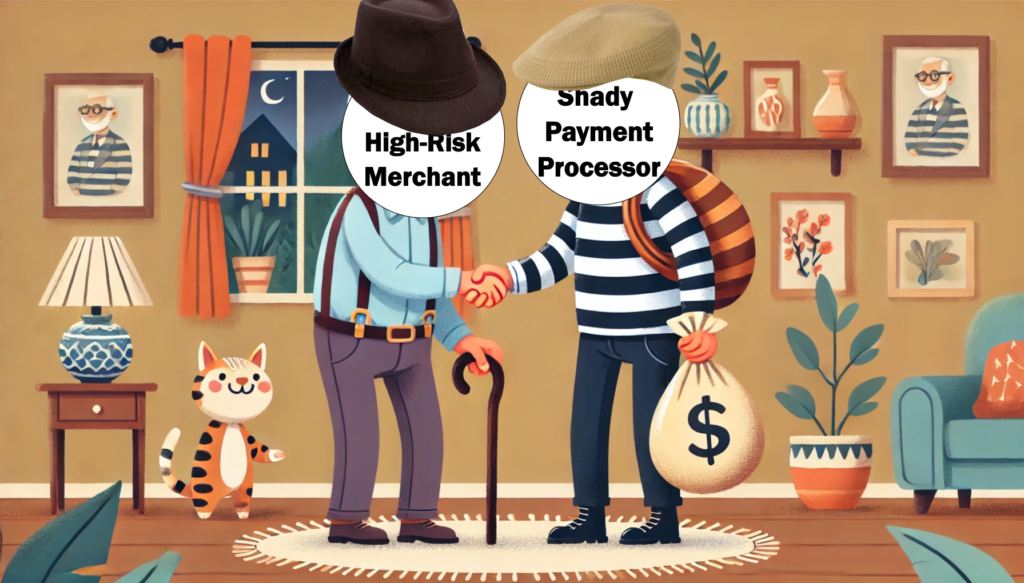As a high-risk merchant, you’re already paying a premium for payment processing. Merchant Discount Rates (“MDR”) of 5-10% (or more) on top of substantial reserve requirements are the norm, and yes, it hurts.
The high cost of doing business in industries like gaming and betting, crypto, or adult entertainment means you’re probably spending a lot of time reviewing fee schedules and hunting for the lowest rate you can find. That’s important – it’s smart to do your homework – but here’s the thing: processors know you’re fixated on rates, so the real risks – where you will lose money – often lie elsewhere in the contract.
Clauses that let processors withhold merchant funds, increase reserve requirements, deduct unspecified liabilities, or delay settlements indefinitely are regularly sprinkled throughout high-risk merchant agreements. These are the clauses that get glossed over because you’re too busy trying to save half a percent on fees. Don’t do that! Look away from the shiny MDR and protect yourself by keeping an eye out for the following four contractual legal landmines:
1. MDR: Too Good To Be True?
A processor offering an unusually low MDR for high-risk merchants will likely try to recoup that discount elsewhere – think higher reserves, broad offset powers, aggressive deductions, and imposing penalties for breaching chargeback thresholds. If it feels like a deal that’s out of line with industry standards, it’s a red flag.
What to do: Do your due diligence! Look for referrals or references from other merchants who have worked with any high-risk processor you are considering. In the contract itself, keep an eye out for “carve-out” clauses that allow the processor to get at your funds, or retain them outright. A low MDR won’t save you if the processor can offset any claimed expenses against your reserve, delay settlements indefinitely, or impose fines and penalties on the merchant directly.
2. Reserves: Well-Structured vs. Black Holes for Disappearing Cash Flow
Reserves are common in high-risk merchant contracts, and the way they are defined and structured makes all the difference when it comes to actually getting reserve funds back. Reserve clauses are where merchants often get trapped by vague or open-ended terms. Look out for the following:
Uncapped Reserves
Example: Many high-risk processors include language entitling the processor to demand reserve amounts be increased, or the right to impose additional “supplementary reserves” and security deposits at the processor’s sole discretion. This is rarely clearly spelled out in the contract, resulting in merchants who are shocked to discover that the hard-fought-for reserve terms set out in the fee schedule have been dismantled by language buried in the body of the agreement.
What to do: Firmly cap the reserve amount. No “wiggle room” clauses that let the processor increase reserves unilaterally, or require that reserves be replenished. If you negotiate 10%, it’s 10%, full stop. Any amendments to the terms should require mutual, written consent.
Undefined Conditions for Reserve Fund Release
Example: We often see broad language along the lines of, “Reserves will be released after 180 days or when all merchant liabilities are settled to the satisfaction of the processor.” The inclusion of merchant liabilities settlement (which the processor always gives itself the power to determine) turns the six-month reserve hold you think you negotiated, into a potentially indefinite lockup.
What to do: Set clear release conditions. Reserves should come back to you after a specific period—say, 180 days post-termination. Anyone reading the contract should know exactly what the deadline is for returning the balance of the reserve. Phrases tying the return of merchant funds to soft targets like “once all merchant liabilities to the processor are settled” spell trouble.
Broad “Off-Set” Rights Against the Reserve Funds
Example: Language allowing the processor to deduct or offset claimed amounts from the reserve funds for broad reasons, i.e., “…any amounts deemed owed, including but not limited to, fines, penalties, fees, anticipated liabilities, or other costs incurred…” is a crimson red flag. This vague language gives the processor unchecked power to deplete your reserve for nearly any reason. Don’t expect to see those funds again. But wait, it gets worse! While less prevalent, we regularly see clauses allowing the processor to seize the entire reserve “for breach of this Agreement.” In which case, RUN.
What to do: Clearly and narrowly define circumstances where deductions from merchant funds (reserves and otherwise) are permissible, and formalize how such deductions will work. Limit the processor’s right to deduct from the reserve to specific circumstances such as (i) chargebacks; (ii) refunds; and (iii) documented fines passed on from card schemes. You’ll also need to push for permissible deductions to come out of the reserve ONLY, not your settlements. Processors will regularly push for the right to dip into settlement funds, which defeats the (stated) purpose of the reserve entirely.
3. Require Supporting Documentation for Everything
This is where most merchants get burned. Processors love vague language that lets them deduct funds for third-party fines, chargebacks, or expenses without showing any requirement of supporting documentation. Look for language like “additional expenses incurred by the processor” or “any fines levied by card networks.” If there’s no requirement for the processor to provide proof that these expenses were incurred, they can just make it up. It may sound far-fetched, but we’ve seen processors seize reserves to cover a claimed 500k fine from Mastercard… which absolutely did not exist.
What to do: If a processor is claiming Visa or Mastercard levied a fine against you, and deducting that amount from your funds, make them show you the paperwork. No documentation? No deduction. Get that in writing. The same goes for any claimed additional expenses, operational costs or chargebacks made more than 180 days post-transaction: any deductions should require supporting evidence and a detailed statement of account. Otherwise, they can slap a “compliance fee” on you and call it a (pay) day.
4. Control Settlement Terms & the Merchant Account
How and when you get paid is one of the most critical parts of your contract. Watch out for language that gives the processor the right to defer settlements indefinitely or freeze the Merchant Account at its discretion for vague reasons.
Example: “Processor may suspend settlements or freeze Merchant’s account without prior notice if it determines, in its sole discretion, that a security issue or potential fraud exists. The freeze will remain until the Processor deems the issue resolved.”
What to do: Take this right out of the processor’s hands. Require that the processor may only delay or withhold settlements, or freeze the Merchant Account if directed by the Acquiring Bank or Card Scheme (and of course, require evidence of any such direction).
Bottom Line
High-risk merchants are inherently vulnerable, but your contract doesn’t have to be the reason you lose sleep – or worse, money. A well-negotiated agreement won’t just protect your profits; it will give you the operational stability you need to focus on running your business. Remember, a low MDR won’t matter if the processor can use other clauses to bleed you dry. The goal isn’t just to secure payment processing services – it’s to secure your bag.
In this article, we’ve gone over four ways that processors can take advantage of vulnerable merchants. But these four contractual tripwires aren’t the only way that you could be getting taken advantage of! If you have questions about negotiating payment processing agreements or recovering receivables, reach out to our team at GME Law. We can help.
This article is intended to provide general information, not official legal advice or opinions of any kind.




